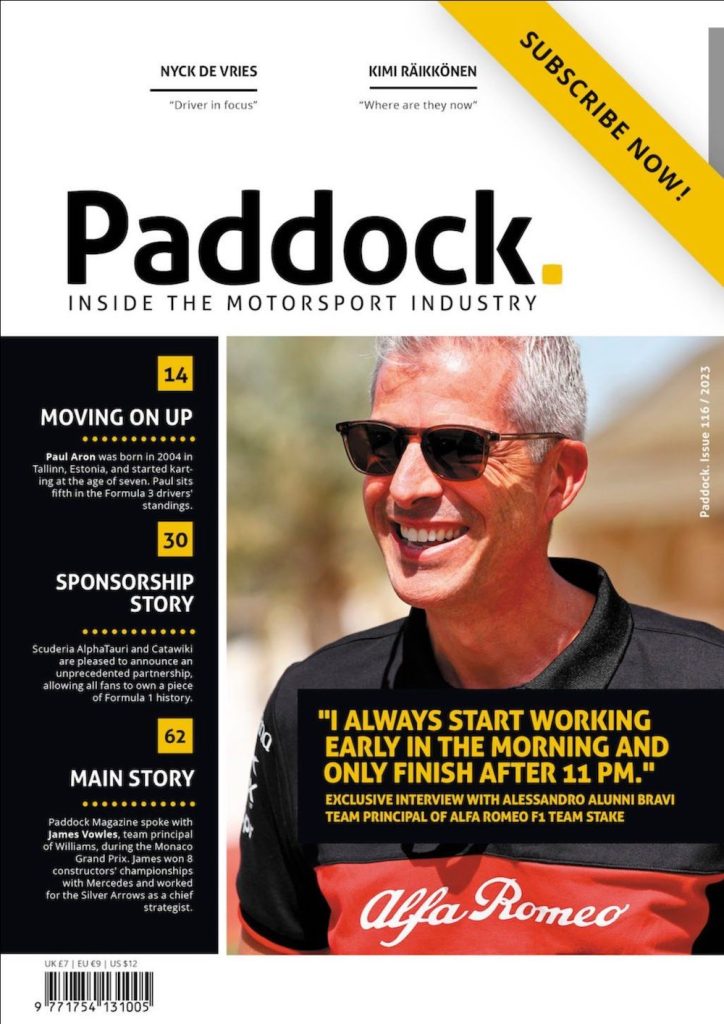David Webb, CEO (Brands) at CSM, is a true professional of sponsorship and marketing, having worked at Jaguar Racing, Stewart Grand Prix, and Just Marketing International to name a few. We’re delighted to have him answer a few questions about the sponsorship side of Formula 1.
Click here to subscribe to our print edition!
David, 2018 seems to be a transitional year for Formula 1 – does the same apply to its sponsorship side?
I think 2018 is the start of a journey. This is Liberty’s second full year now in reviewing what Formula 1 is all about.
Is it a transitional year? I think every year is going to be a transitional year the more they get under the skin of the sport, and so the offering will only get greater. The opportunity for sponsors to get in early is certainly there. However, at the moment sponsors are holding back until they are able to tell a story that’s complete – until the dots have been joined from how you are able to engage the fan, to how you can relate it to sales and into the retail environment.
I think that the whole journey is developing and they’ve bought in some good people to be able to tell that story and so the opportunity is certainly there.
There’s a split opinion out there about social media’s effect on actual sales. What’s your take on the way social media correlates with selling a sponsor’s products/services in practice?
Social media can act as a very fruitful channel for driving awareness, engagement and generating referral traffic to brands owned properties.
Social media, when coupled with 1st party data and intelligence from a brands CRM, can be a powerful way to drive actions from a segmented audience (for example, driving brand consideration or conversions of particular products or services).
Some of the major social networks have flirted with direct sales through social, but it seems there is still some way to go for brands to see positive ROI from social directly. Instagram is testing new updates to enable brands to sell directly from tagged images or stories, so it will be interesting to see if these drive a positive return for brands.
The brand platform that Formula 1 is trying to create is probably still missing.
Talking about digital strategies, what would you say sponsors/partners are getting in Formula 1, and how could that be improved?
It is now common practice for sponsors to use the digital channels of Formula 1 or a particular team to distribute branded content, in the past, this obviously wasn’t the case. Drivers are now regularly posting on their own channels too, bringing more personality into the mix. This provides an opportunity for brands to authentically integrate their products/services to a receptive audience.
Many digital strategies follow a “get it out there” approach through regular posting, peaking around key races.
Generally, does Formula 1 look strong to you in terms of attracting more big sponsors like Rolex or Emirates at the moment?
If they can get the Formula 1 “story” sorted, in terms of being able to connect more to the fan, and connecting brands more to the customer, then they’ll get it right and will attract big brands, I’m sure of it.
If I am the CMO of any major organisation, and you bring to me any form of sponsorship, I’m going to ask “so what?” What is it going to do for me as a brand? What is it going to do for me to help drive sales? How are we going to be able to do that?
Formula 1 being able to answer these questions will come through the investment they make in creating their unique “story”.
Can you already see the image that Formula 1 under Liberty Media will have among potential sponsors in the future?
No, I think I can’t – the brand platform that Formula 1 is trying to create is probably still missing. What is it that Formula 1 stands for? That’s not been answered yet. Again, that will become part of the development of the brand: how is it communicated in various different ways and what will it take to create.
What do you think about the calendar of 2018, and what, in your opinion, will the changing calendar do to the sponsorship deals?
Formula 1 is all about the calendar, which has always changed. It’s gone to Malaysian markets, the Korean and Chinese markets, it’s gone to markets where you wouldn’t actually think there was a very strong Formula 1 audience.
America will become the second biggest market (with Europe as the largest, and Asia in third), and so the demand for sponsorship will increase, and we will see more sponsors coming into the sport because of the nature of the change. But that is still to be defined and refined.
The story still hasn’t been told about the changes in the calendar – why, what are the positives, asking the “so what?” question of going to these countries and what it will do to benefit the partners and sponsors.











Related Articles